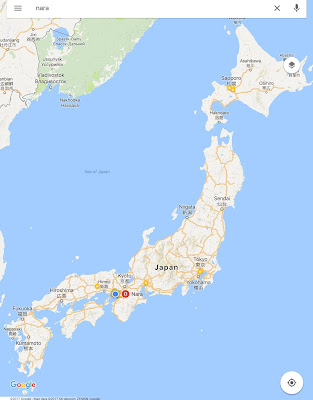Today, we would like to talk about religions in Japan. Most Japanese do not actively believe in any religion. However, Buddhism has a very strong influence in our daily lives.
During August, we have a big holiday season called obon. It is an annual Buddhist event to commemorate our ancestors and is observed from August 13th to August 15th. It is believed that our ancestors' spirits return to this world during obon, and there are many festivals throughout Japan to celebrate it. With another national holiday and weekends, it can be a long holiday season, and many people also go back and visit their families during obon like you do on Thanksgiving in the US.
On the first day of our obon holiday season this year, we decided to visit Todaiji Temple in Nara (red dot in the map below)!
Todaiji Temple is one of UNESCO World Heritage Sites.
In 7th century Japan, there were many natural disasters, rebellions, and epidemics. Emperor Shomu decided to govern the country with help from gods, and he promoted the construction of provincial temples all over Japan, and Todaiji Temple was officially appointed as the head of all those temples in 752. Nara was the capital of Japan when Todaiji Temple was built.
Ancient Japanese believed that deer are messengers of gods so they were treasured and protected. To this day, there are many deer walking around Nara Park!
Yuki loves animals, so he was very excited to see all those deer walking around Nara Park!
At Nandaimon Gate:
When you stand under Nandaimon Gate, you see 2 big guardian statues, Agyou on your right and Ungyou on your left watching over the temple. They are 8.4m (27ft 6.7in) tall! Their faces look very scary... but Yuki thought their posing was rather funny!
After Nandaimon Gate, there is yet another gate called Chumon Gate.
And finally inside Great Buddha Hall is Daibutsu of Nara, which is the biggest bronze Buddha statue in the world at about 15m (49ft 2.6in)!
Emperor Shomu expected citizens to make many offerings including bronze and rice to make Great Buddha, so citizens suffered a lot in order to build this Great Buddha and the country almost went bankrupt. It is said that 2,600,000 people (1/3 of the population at the time) helped making this Buddha, taking 9 years!
There was a golden statue on each side of Buddha. So, there were one Great Buddha and 2 small golden Buddhas...
This hole on the pillar is the same size as the nostril of Great Buddha, and it is believed that if you go through it, you will stay healthy and free from any harm all your life. We also read that it is believed that if you could go through this hole on the pillar, you are guaranteed a place in heaven!?!? Yuki's mom went through this hole when she was little, and this day, Yuki and Tag went through it, too!
Nara Park was very big, and there were many other temples and shrines besides Todaiji Temple! It was like one big hiking trail in the forest with so many beautiful historical sights to see! We enjoyed it very much and wished we had one more day to explore!
These are called ema (picture horse). Ancient people would donate horses, which were considered holy and were the symbol of power, to shrines to have their prayers heard. However, since most people could not donate horses, they started offering horses made from wood and cray. That eventually turned into wooden plaques that shrines would sell for a small fee, on which people would write their prayers or wishes.
This is called chozuya. They have one at every shrine so you can purify yourself before approaching the main shrine. There is a certain way to do this. First, you bow lightly in front of chozuya. Then, you hold the water ladle with your right hand and get water in the water ladle. Then, you wash your left hand. Then, you hold the water ladle with your left hand and wash your right hand. Then, hold the water ladle with your right hand again and pour water in your left palm and wash your mouth with the water in your left palm. Finally, you hold the ladle up so the remaining water will wash the ladle and you put it back on chozuya. Phew...! So much to do, huh!
Lanterns were placed throughout Nara park in preparation for obon festival when we visited. We decided to come home before it became dark, because we were getting very tired and also our kitties were waiting for us at home. So, we did not get to see those lanterns being lit...
After Todaiji Temple was built, the power of Buddhism became very strong in Japan, and it even started to interfere greatly with politics. So, they eventually decided to move the capital from Nara to Nagaoka in 784.
After our trip to Todaiji Temple in Nara, we visited Itsukushima Shrine in Hiroshima. In our next post, we want to talk about Shinto, another religion beside Buddhism that has a big influence in Japanese culture. So, stay tuned for our next post!

































WOW! This was one of our favorite posts yet! What a beautiful place, and thank you for teaching us so much about Japanese heritage. And thank you so much for taking such cute pictures with Tag. He looks like he is being very well-cared for.
ReplyDeleteWe would love to learn more about traditions during Obon- is there a big meal? What do you eat? What else do you do to celebrate? Maybe next year we can celebrate it here in the U.S.!